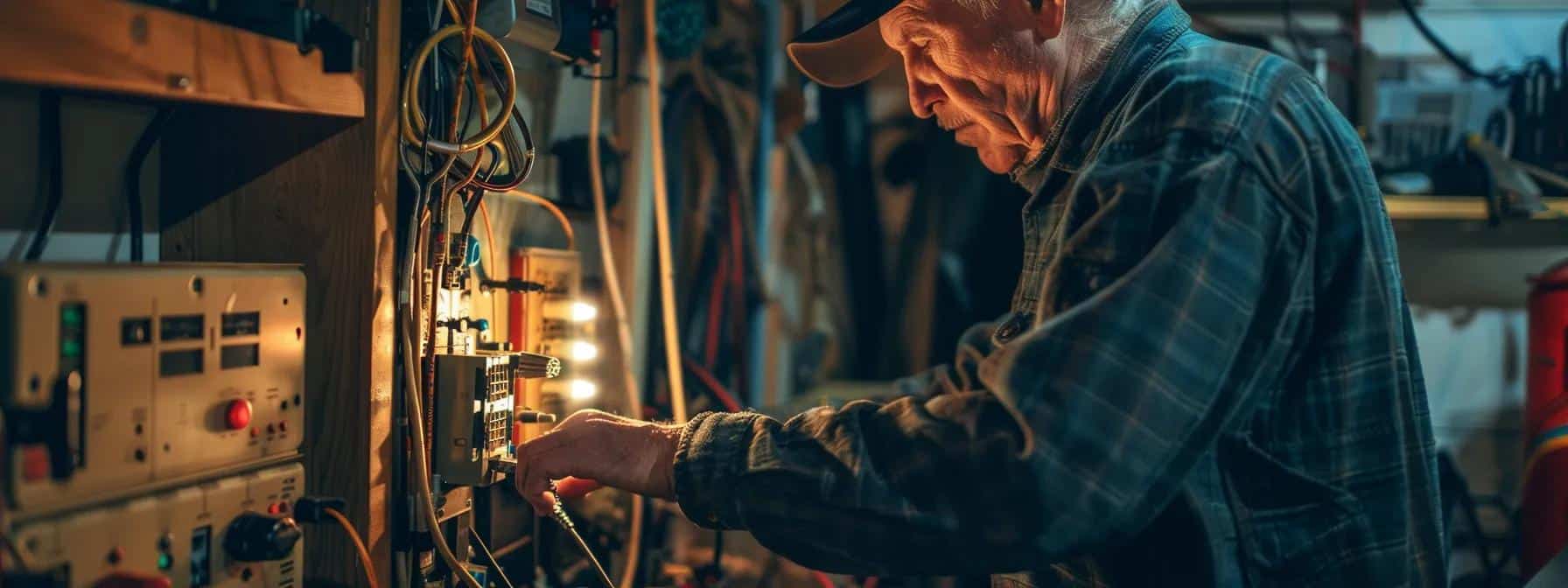Why Old Homes May Face Wiring Issues
Old homes often encounter wiring issues that affect safety, functionality, and property value. Aging electrical systems may not meet modern standards, increasing risks of fire and electrocution. This article details common wiring problems in older homes, discusses building codes and electrical load calculations, highlights wiring upgrade benefits, stresses preventative maintenance, and explains when to consult an electrician. Understanding these issues helps homeowners plan effective upgrades and secure their properties.
Identify Common Wiring Problems in Older Homes
Older homes typically suffer from outdated electrical systems, frayed wiring, overloaded circuits, faulty fixtures, and insulation degradation. These issues arise from aging components and non-compliance with today’s safety standards.
Examine Outdated Electrical Systems and Their Risks
Old wiring often uses materials and methods no longer considered safe, leading to inconsistent voltage delivery and an increased risk of short circuits. Such systems can compromise fire protection and cause electrical shocks.
Inspect for Frayed Wiring and Insulation Issues
Wear and tear over time commonly result in frayed wiring and damaged insulation. Exposed wires not only create sparks but also accelerate insulation breakdown, increasing the risk of fire and shocks.
Recognize Signs of Overloaded Circuits in Historical Homes
Older homes may face circuit overloads due to the addition of modern appliances. Frequent tripping breaker, flickering lights, and warm outlets indicate that the existing circuits cannot handle increased electrical demands.
Identify Faulty Fixtures and Their Impact on Safety
Inadequate grounding and poorly maintained fixtures can lead to erratic lighting and complete fixture failure. Such issues not only impair functionality but also raise the chances of electrical fires and shocks.
Assess Potential Fire Hazards Associated With Old Wiring
Wiring that lacks proper grounding or uses outdated materials poses significant fire hazards. Loose connections and insufficient insulation can cause overheating, potentially igniting nearby combustible materials.
Understand How Aging Affects Wiring Systems Over Time
Repeated heating and cooling cycles, physical wear, moisture intrusion, and corrosion collectively weaken electrical wiring over time. Homeowners must recognize these cumulative effects to plan necessary upgrades.
Understand Building Codes for Electrical Systems

Local building codes play a crucial role in ensuring wiring safety. As codes have evolved since many older homes were built, they can expose gaps in existing installations.
Research Local Building Codes and Their Implications
Homeowners should review local building codes to understand updates needed for safe wiring installations. These codes outline critical legal and safety requirements for modifications and upgrades.
Analyze How Codes Have Changed Since Home Construction
Older wiring may have once been compliant but now falls short of modern standards. Recognizing these changes is essential to identify necessary updates for achieving current safety benchmarks.
Discover Compliance Challenges for Older Homes
Outdated wiring, insufficient grounding, and non-standard layouts present common compliance issues. Remediation often requires professional assessment to ensure the home meets today’s electrical safety standards.
Review the Need for Updates to Meet Current Standards
Upgrades such as installing new wiring, modern circuit breakers, and improved grounding systems are essential. Ensuring compliance reduces hazards and supports modern electrical demands.
Explore the Impact of Non-Compliance on Home Safety
Non-compliance with updated codes can result in electrical fires, shocks, and power outages, along with higher insurance premiums and potential legal liabilities.
Know When to Consult a Professional for Inspections
Because older electrical systems can be complex, professional inspections are necessary. Licensed electricians can assess wiring issues comprehensively and advise on essential upgrades.
Investigate the Role of Electrical Load Calculations
Proper electrical load calculations are key to maintaining a safe wiring system in older homes. Modern appliances can significantly increase the load on these outdated circuits.
Learn How to Calculate the Electrical Load Requirements
Calculating the electrical load involves summing the wattage of all devices to ensure circuits are not overloaded. This practice helps prevent excessive current draw, which can lead to overheating and fires.
Determine the Impact of Modern Appliances on Wiring
Modern appliances like dishwashers, refrigerators, and smart devices demand stable voltage and current. Their increased load can stress old wiring systems that were not designed for contemporary usage.
Evaluate Load Distribution Across Circuits in Old Homes
Proper load distribution maintains optimal performance. Balancing electrical loads prevents frequent breaker tripping, which helps extend the wiring system’s lifespan.
Identify Signs of Overloading Due to Increased Usage
Indicators such as persistent breaker trips, dimming lights when multiple devices run, and warm outlets reveal that circuits are overloaded. Early recognition of these signs facilitates timely upgrades.
Consider Options for Upgrading Service Panels if Needed
Modern service panels with higher capacity can better handle increased electrical demands. Upgraded panels improve safety and provide room for future technological advancements and appliance upgrades.
Understand the Benefits of Load Balancing in Electrical Systems
Effective load balancing reduces the risk of overheating, improves performance, and minimizes energy waste by ensuring every circuit carries an even share of the load.
Explore Benefits of Wiring Upgrades

Wiring upgrades bring advantages such as better energy efficiency, enhanced safety, and increased property value. Updated systems incorporate advanced technologies for improved performance.
Discover the Advantages of Modern Wiring Systems
Modern wiring uses insulated copper lines, advanced grounding techniques, and efficient circuit layouts. These enhancements significantly reduce energy loss and risk factors compared to outdated systems.
Investigate Energy Efficiency Improvements From Upgrades
Upgrades minimize resistance and optimize circuit performance. Smart monitoring components can detect wasted energy, ultimately helping homeowners save on energy costs.
Review Safety Enhancements From New Electrical Installations
New installations adhere to the latest safety codes, reducing hazards like overheating, shocks, and electrical fires. Improved insulation and grounding add essential protection layers.
Consider Increased Home Value With Updated Wiring
Updated wiring increases a home’s market value. Modern electrical systems are attractive to buyers and can lead to faster sales and better offers during property transactions.
Understand Convenience Improvements With Technology
Modern wiring supports home automation, smart devices, and energy management tools. These innovations provide the convenience of integrated control over lighting, heating, and security systems.
Examine Long-Term Savings From Reduced Electrical Issues
Wiring upgrades lower maintenance costs and reduce the frequency of disruptions caused by electrical failures. Over time, savings accrue from fewer repairs, lower energy bills, and improved system reliability.
Learn About Preventative Maintenance for Wiring
Preventative maintenance is vital to ensure the integrity of wiring systems in older homes. Regular inspections and timely repairs help minimize hazards and extend system life.
Establish a Schedule for Electrical Inspections
Regular professional inspections can catch potential issues early. Many experts recommend annual check-ups to ensure wiring remains safe and compliant with current standards.
Identify Routine Checks to Ensure Safe Operation
Routine maintenance includes checking outlets, verifying grounding, testing circuit breakers, and inspecting wires for wear. These simple steps help prevent larger safety issues.
Understand the Significance of Professional Evaluations
Professional assessments provide insights beyond surface-level checks. Licensed electricians can detect underlying problems that might be missed during routine inspections.
Evaluate the Importance of Keeping Up With Repairs
Prompt repairs, such as replacing worn cables or connectors, are essential. Maintaining the electrical system prevents minor issues from becoming significant safety risks.
Know How to Respond to Warning Signs Immediately
Unusual smells, sparks, or frequent breaker trips require immediate attention. Responding quickly to these warning signs minimizes risks and prevents extensive damage.
Create a Maintenance Checklist for Older Electrical Systems
A detailed checklist tracking inspection dates, issues found, repairs made, and future recommendations can help homeowners manage and plan their electrical maintenance.
Know When to Consult an Electrician for Help

Knowing when professional help is needed is crucial for electrical safety in older homes. Certain situations require the expertise of a licensed electrician.
Recognize Situations That Require Professional Intervention
Persistent electrical faults, recurring breaker trips, or visibly damaged wiring are clear signs that professional help is needed. Qualified electricians can accurately diagnose and safely resolve these issues.
Learn How to Select a Qualified Electrician for Assessments
Verifying licensing, reading reviews, and assessing past work are key to selecting a competent electrician experienced with older wiring systems.
Evaluate the Costs Associated With Hiring a Specialist
While hiring an electrician incurs costs, professional repairs can prevent more extensive and expensive damage in the future. Long-term savings and safety improvements justify the expense.
Understand the Importance of Getting Multiple Quotes
Comparing multiple quotes ensures homeowners receive quality service at competitive pricing, maintaining both safety standards and cost-effectiveness.
Familiarize Yourself With the Electrician’s Recommendations
A reliable electrician should clearly explain the work needed and the benefits of upgrades. Homeowners are encouraged to ask detailed questions and request written estimates.
Know the Benefits of Ongoing Partnerships With Electricians
Long-term service agreements with a trusted electrician can streamline future maintenance and upgrades, ensuring that emerging issues are addressed promptly.
Final Thoughts
Old homes face challenges due to outdated wiring and non-compliance with modern standards. Understanding common wiring issues, staying updated with building codes, and enforcing regular maintenance can greatly enhance safety and efficiency. Upgrading electrical systems not only improves energy efficiency and reduces hazards but also increases home value and convenience. For optimal safety, consulting qualified electricians early and maintaining ongoing professional relationships is essential.
Frequently Asked Questions
Q: What are the primary risks of outdated wiring in older homes? A: Outdated wiring poses risks such as circuit overloads, fire hazards, and electrical shocks due to degraded insulation and non-compliance with modern standards.
Q: How often should electrical inspections be conducted in older properties? A: Annual inspections are recommended to ensure wiring remains safe and compliant with current building codes.
Q: Why is load balancing important for older wiring systems? A: Load balancing prevents circuit overloads by evenly distributing electrical demand, thereby reducing the risk of overheating and failures.
Q: When should a homeowner consult a professional electrician? A: Homeowners should seek professional help when experiencing frequent breaker trips, visible wiring damage, or electrical issues beyond basic troubleshooting.
Q: What are the benefits of wiring upgrades in older homes? A: Wiring upgrades improve energy efficiency, enhance safety, support modern appliances, and increase a property’s overall market value.

